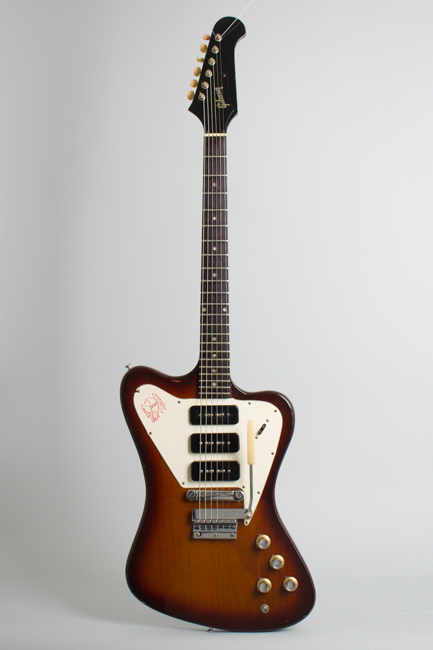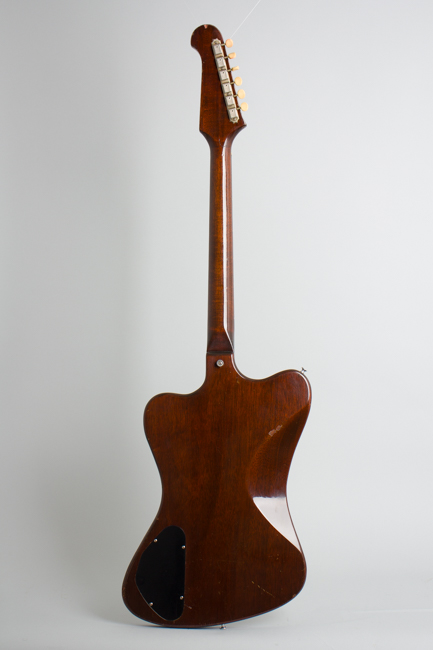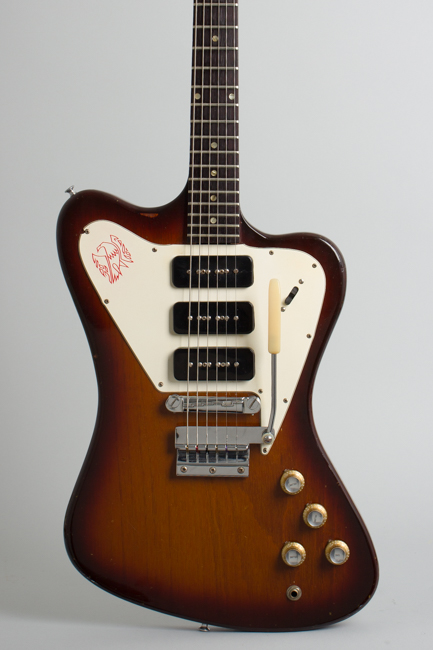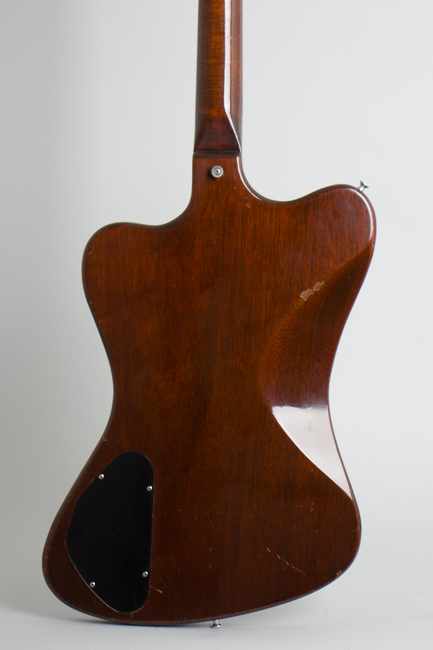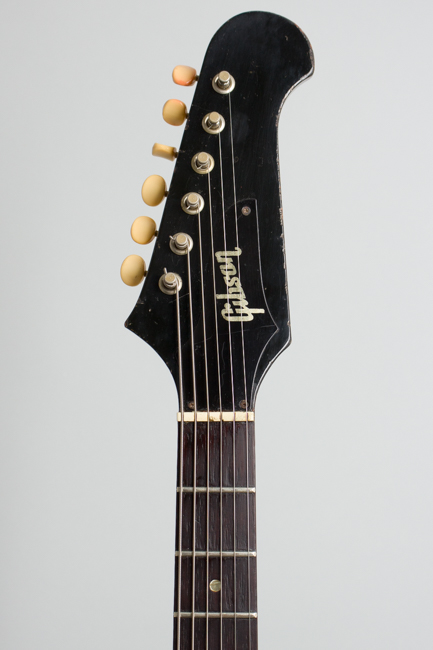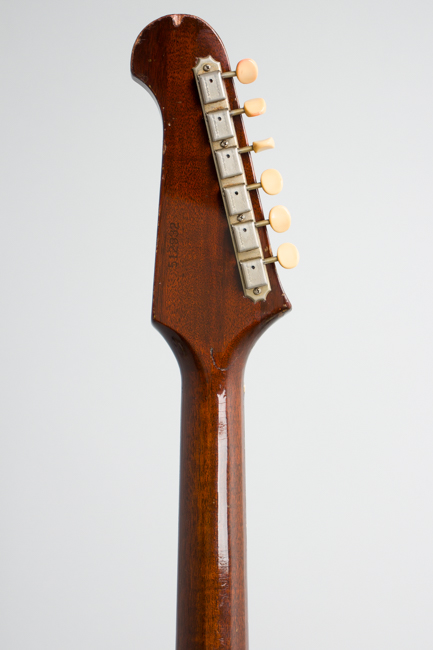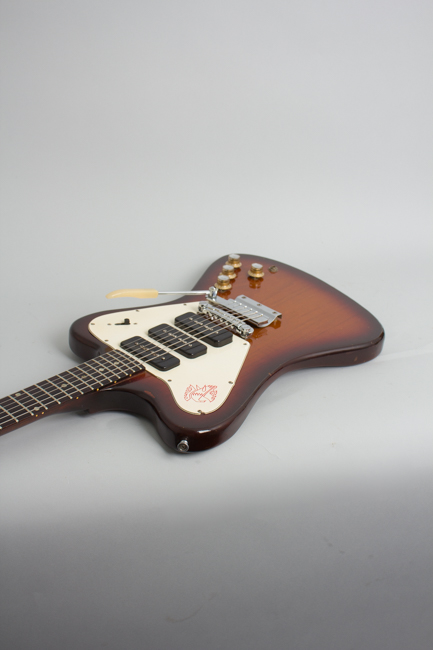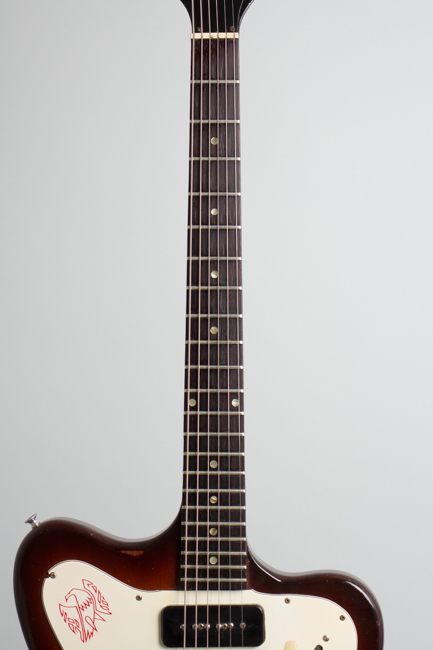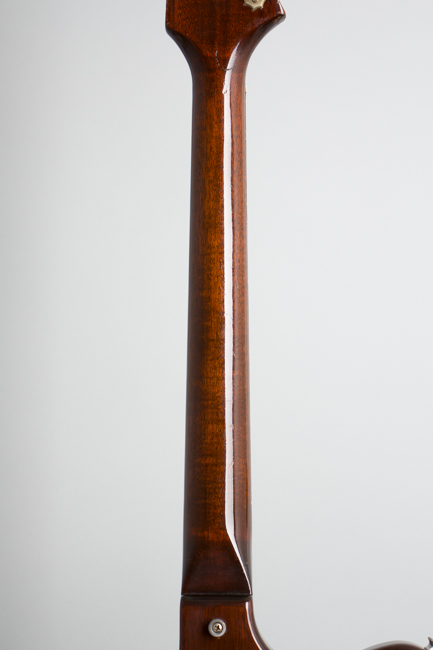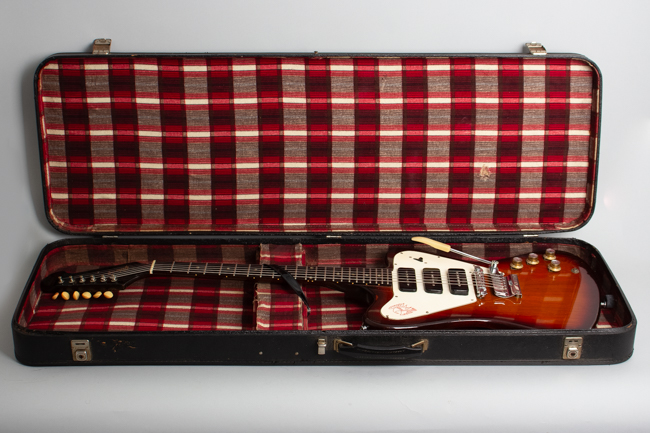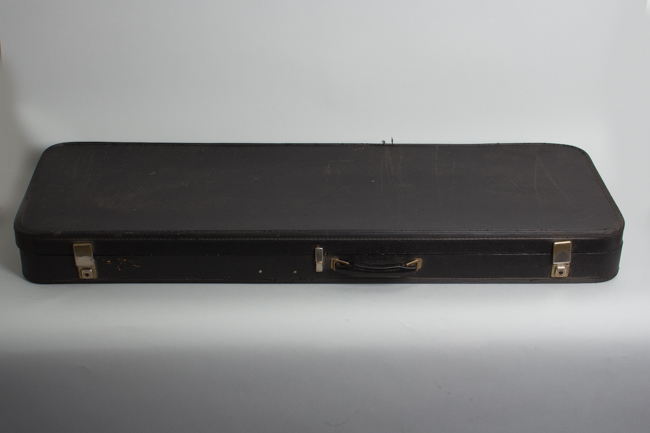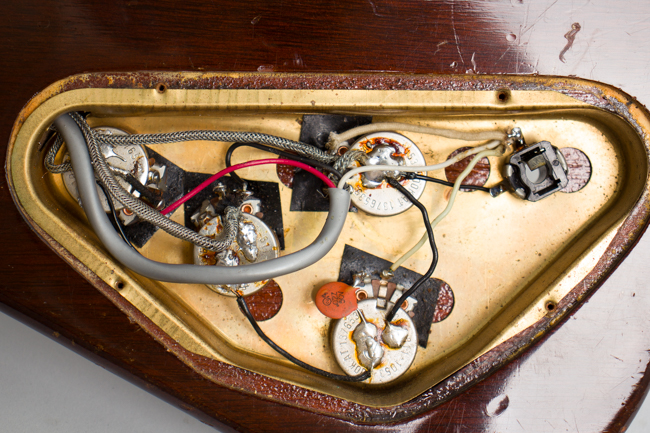Gibson Firebird III Solid Body Electric Guitar (1965)
This item has been sold.
Item # 12233
Prices subject to change without notice.
Gibson Firebird III Model Solid Body Electric Guitar (1965), made in Kalamazoo, Michigan, serial # 512932, sunburst lacquer finish, mahogany body and neck, rosewood fingerboard, original black hard shell case.
This is a neat player's example of a late 1965 "non-reverse" Firebird III, with some minor repair and interesting (if invisible) electronics work making it a more versatile sounding piece than in its original layout. The headstock has a small repaired "Smile" crack just above the nut, not a full break. This is solidly glued up with some minimal touchup. There was also a fingerboard separation on both sides behind the nut; this has been repaired with no touchup so is solid but visible. Both repairs are very common with these Firebirds.
The neck pickup is the original P-90, the bridge and middle are a more recent Seymour Duncan vintage style P-90 set. Typically for Gibson the original wiring offered only three pickup settings: bridge alone, neck alone and bridge and middle out-of-phase. This guitar has been re-wired in a conventional two pickup setup, either or both selected by the 3-way switch each with its own volume knob. The middle pickup is controlled by an independent volume knob and can be blended into any setting, or used alone. The tone knob is a master working on all settings. This much more versatile wiring required no structural modifications (the guitar looks stock) and offers a much wider palette of sound than the original scheme.
These the second-try Firebird models were for a long time one of Gibson's less heralded 1960s classics; lower-priced, simplified versions of the earlier "reverse" body Firebird series guitars. Introduced in at the summer NAMM show in 1965, the new Firebirds were available through the late 1960s in dwindling quantities, but never really caught on in a big way.
This midline-model Firebird III dates to the first production year 1965 and is finished in the standard sunburst, by far the most common livery. The fluidly sculpted Honduras mahogany body is mated to a one-piece glued-in neck, far simpler to build than the original laminate neck-through-body Firebird design. The rosewood fingerboard is unbound and dot inlaid, unlike earlier versions it is the same for all models.
The non-reverse III is distinguished by offering not two but three plastic-covered P-90 pickups, an unusual combination that Gibson had not used before on a solid body instrument. Typically for late 1965 this 'bird mounts chrome plated hardware, including Gibson's "short" Vibrola unit with a plastic-tipped handle and the stud-mounted solid bridge. These Firebirds were fitted with a fairly cheap slider switch for pickup selection that often broke; this one is a correct-style replacement. The tuners are plastic-button Kluson Deluxe in a single 6-unit strip that Gibson used on only a few models.
The visible pot codes date to the 39h week of 1965; the serial number starting with 512 is a series used by Gibson in both 1965 and '68 but the features indicate assembly in late 1965 or early 1966. The pickups are mounted directly to the body not to the pickguard as they were after 1966. The nut width is the slimmer 1965 and later style shared by all second generation Firebirds, narrower than earlier "reverse" Firebird necks but fattening up as it approaches the body, not as super-skinny as many period SG necks.
This is a great playing and really cool sounding guitar, with powerful P-90 pickups that really growl when cranked some interesting and unusual sounds in the modified blended multi-pickup mode. While the "non-reverse" Firebirds often used to be discounted in Gibson history, they have found a growing cadre of enthusiasts in the 21st century, enough for Gibson to finally re-issue the model recently. They remain distinctive guitars unlike any other in look or feel and excellent players instruments. Extremely light, fast playing, and super stylish, this Firebird III is a cool player's example of an oft-underappreciated Gibson model, an unrepentant rocker's guitar.
Overall length is 43 3/8 in. (110.2 cm.), 13 7/16 in. (34.1 cm.) wide at lower bout, and 1 3/8 in. (3.5 cm.) in depth, measured at side of rim. Scale length is 24 3/4 in. (629 mm.). Width of nut is 1 5/8 in. (41 mm.).
Apart from the common if fairly minimal repairs this is a decently well-preserved 'bird for nearly 60 years on the planet, the finish remaining original showing some fairly light typical wear overall. As noted the headstock and fingerboard show visible repairs, done solidly with no lacquer overspray. There are no other cracks or structural repairs. The original finish shows some light checking and a varied collection of dings, dents and chips, most heavily on the body edges with a larger rubbed through spot on the peak of the lower treble bout. The fairly dark sunburst on the face shows minimal fading. The headstock edges have some typical rubs and small chips, with one larger chip on the rear top edge.
The pickups and wiring have been modified as noted above; the two rear pickups, switch and some wiring are more recent. All pots are original coded 6539 dating to the second half of 1965. The knobs are modern repros of the 1965 "capped" style properly marked for the revised operation of the knobs (three volumes and one tone). All other hardware is original and complete. The pickguard shows a small piece missing at the shrinkage crack off the uppermost screw and some light pulls in several places but is otherwise intact. The often-faded bird emblem is nicely bold and intact. Many of these pickguards have shrunken up far worse than this one has!
The original frets show light wear and still have plenty of meat to them, and most importantly the neck angle on this guitar is much better than many allowing the vibrato to function properly. Overall a fine playing and pretty unique sounding Firebird, not all original but in exchange offering a lot of sonic options usually left unheard on 3-pickup Gibsons. It cones complete in its original "Picnic basket" HSC lined with plaid checked fabric. Overall Very Good + Condition.
This is a neat player's example of a late 1965 "non-reverse" Firebird III, with some minor repair and interesting (if invisible) electronics work making it a more versatile sounding piece than in its original layout. The headstock has a small repaired "Smile" crack just above the nut, not a full break. This is solidly glued up with some minimal touchup. There was also a fingerboard separation on both sides behind the nut; this has been repaired with no touchup so is solid but visible. Both repairs are very common with these Firebirds.
The neck pickup is the original P-90, the bridge and middle are a more recent Seymour Duncan vintage style P-90 set. Typically for Gibson the original wiring offered only three pickup settings: bridge alone, neck alone and bridge and middle out-of-phase. This guitar has been re-wired in a conventional two pickup setup, either or both selected by the 3-way switch each with its own volume knob. The middle pickup is controlled by an independent volume knob and can be blended into any setting, or used alone. The tone knob is a master working on all settings. This much more versatile wiring required no structural modifications (the guitar looks stock) and offers a much wider palette of sound than the original scheme.
These the second-try Firebird models were for a long time one of Gibson's less heralded 1960s classics; lower-priced, simplified versions of the earlier "reverse" body Firebird series guitars. Introduced in at the summer NAMM show in 1965, the new Firebirds were available through the late 1960s in dwindling quantities, but never really caught on in a big way.
This midline-model Firebird III dates to the first production year 1965 and is finished in the standard sunburst, by far the most common livery. The fluidly sculpted Honduras mahogany body is mated to a one-piece glued-in neck, far simpler to build than the original laminate neck-through-body Firebird design. The rosewood fingerboard is unbound and dot inlaid, unlike earlier versions it is the same for all models.
The non-reverse III is distinguished by offering not two but three plastic-covered P-90 pickups, an unusual combination that Gibson had not used before on a solid body instrument. Typically for late 1965 this 'bird mounts chrome plated hardware, including Gibson's "short" Vibrola unit with a plastic-tipped handle and the stud-mounted solid bridge. These Firebirds were fitted with a fairly cheap slider switch for pickup selection that often broke; this one is a correct-style replacement. The tuners are plastic-button Kluson Deluxe in a single 6-unit strip that Gibson used on only a few models.
The visible pot codes date to the 39h week of 1965; the serial number starting with 512 is a series used by Gibson in both 1965 and '68 but the features indicate assembly in late 1965 or early 1966. The pickups are mounted directly to the body not to the pickguard as they were after 1966. The nut width is the slimmer 1965 and later style shared by all second generation Firebirds, narrower than earlier "reverse" Firebird necks but fattening up as it approaches the body, not as super-skinny as many period SG necks.
This is a great playing and really cool sounding guitar, with powerful P-90 pickups that really growl when cranked some interesting and unusual sounds in the modified blended multi-pickup mode. While the "non-reverse" Firebirds often used to be discounted in Gibson history, they have found a growing cadre of enthusiasts in the 21st century, enough for Gibson to finally re-issue the model recently. They remain distinctive guitars unlike any other in look or feel and excellent players instruments. Extremely light, fast playing, and super stylish, this Firebird III is a cool player's example of an oft-underappreciated Gibson model, an unrepentant rocker's guitar.
Overall length is 43 3/8 in. (110.2 cm.), 13 7/16 in. (34.1 cm.) wide at lower bout, and 1 3/8 in. (3.5 cm.) in depth, measured at side of rim. Scale length is 24 3/4 in. (629 mm.). Width of nut is 1 5/8 in. (41 mm.).
Apart from the common if fairly minimal repairs this is a decently well-preserved 'bird for nearly 60 years on the planet, the finish remaining original showing some fairly light typical wear overall. As noted the headstock and fingerboard show visible repairs, done solidly with no lacquer overspray. There are no other cracks or structural repairs. The original finish shows some light checking and a varied collection of dings, dents and chips, most heavily on the body edges with a larger rubbed through spot on the peak of the lower treble bout. The fairly dark sunburst on the face shows minimal fading. The headstock edges have some typical rubs and small chips, with one larger chip on the rear top edge.
The pickups and wiring have been modified as noted above; the two rear pickups, switch and some wiring are more recent. All pots are original coded 6539 dating to the second half of 1965. The knobs are modern repros of the 1965 "capped" style properly marked for the revised operation of the knobs (three volumes and one tone). All other hardware is original and complete. The pickguard shows a small piece missing at the shrinkage crack off the uppermost screw and some light pulls in several places but is otherwise intact. The often-faded bird emblem is nicely bold and intact. Many of these pickguards have shrunken up far worse than this one has!
The original frets show light wear and still have plenty of meat to them, and most importantly the neck angle on this guitar is much better than many allowing the vibrato to function properly. Overall a fine playing and pretty unique sounding Firebird, not all original but in exchange offering a lot of sonic options usually left unheard on 3-pickup Gibsons. It cones complete in its original "Picnic basket" HSC lined with plaid checked fabric. Overall Very Good + Condition.
